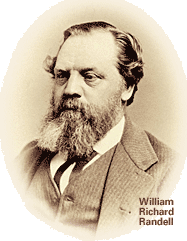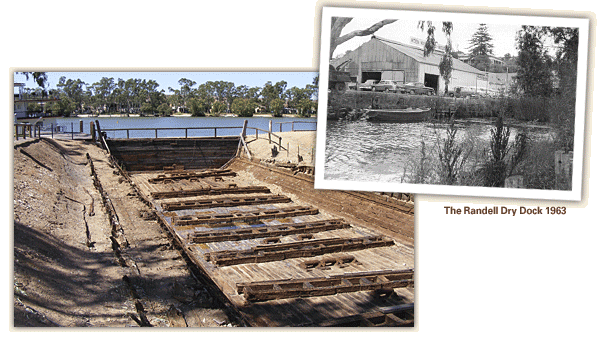Listed on the South Australian State Heritage Register and the Register of the National Estate, the Randell Dry Dock was designed and constructed as a timber floating dry dock in 1873 for use on Lake Alexandrina. The dock proved to be a failure in its intended use, due to the limited water depth in the Lake, but was soon converted to a graving dry dock. It is one of a few timber floating dry docks to have been constructed in Australia, and was the only graving dock on the inland river system.
The installation of the Dock at Mannum greatly extended a small existing ship building and repair facility that had been developed by Captain William Richard Randell since forming his base on this portion of the River Murray in the 1850’s. Being the only facility of its type on the inland river system it attracted a large number of river vessels for repair and re-fitting, with up to 30 vessels using the dock per year. It is estimated that over half of all vessels in use on the river system used the Dock at some time. The Dock and its associated workshops consequently had a significant role in employing local shipwrights and tradesmen, and provided the core required to maintain local ship building industry.

The construction of the Dock at Milang and its opening at Mannum three years later coincides with the peak of the significant river trade which had facilitated the development of much of the inland areas of South Australia, Victoria and New South Wales. River trade patterns were to change during the late 1870’s and 1880’s as railways reached the Rivers and heralded the gradual decline in the River trade. While Mannum declined as a port, the Dock flourished during this period and over the next fifty years until it was replaced by a new slip at Morgan in the late 1920’s.
The Dock has a strong association with a number of individuals who were extremely influential in the development of the River Murray trade. The merchant AH Landseer from his headquarters at Milang did much to foster the river trade by providing an efficient and cost effective outlet for wool and a source of up river cargoes. By the early 1870’s, over half of the wool for direct export passed through his business, as well as the majority of export goods for up river destinations. Landseer also owned a fleet of river vessels, for the repair of which he commissioned the floating dry dock in 1873.
Captain William Richard Randell was the pioneer navigator of the inland river system, having through his own initiative designed, built and sailed the first river steamer, the PS Mary Ann, in 1853. Randell and the Mary Ann, took part in the famous up river race with Captain Cadell in 1853, and he pioneered navigation of many of the rivers of the system, testing the limits of navigation. Randell made Mannum his base, subdivided the land for the current centre of the town and constructed his home, Bleak House, on the ridge overlooking the dock. He had used Mannum for the construction and repair of his own river vessels, and had constructed a slip there in the 1860’s. In 1874 he purchased Landseer’s failed floating dry dock and towed it to Mannum, where he supervised its installation into the river bank to form the current dry dock. In association with his partners, in 1880 Randell commissioned and supervised alterations to the Dock, and in which configuration it remains today. Despite moving from Mannum in 1876, Randell maintained his strong associations with the river and Mannum, maintaining his fleet and the ownership of the Dock until his death in 1911.

On Randell’s death the Dock was purchased by Captain Johan Georg Arnold. A Swedish sailor, he had made Mannum his base and in the 1890’s had begun to build up a fleet of river vessels, eventually combining with the other major ship owners to form Murray Shipping Limited. He owned local business and won Government tenders for the supply of materials and construction of barges for the construction of the locks. He also played a role in the evolution of the river trade, as a major buyer of wheat for the expanding farm land of the Murray Mallee, his barges carried wheat to Goolwa and his passenger vessels helped to develop a new tourist trade.
Arnold gave the Dock a new impetus, by upgrading its facilities and providing good management, it continued its role as a major river vessel repair facility and provided the basis for his new ship building slips. With the construction of a Murray Shipping Limited slip at Morgan, the Dock was closed in the late 1920’s.
The Key’s Beam Engine was built by John Key of Kircaldy and was used to pump water from the dock when a paddle steamer was inside. An engine of this type would use a beam. The connecting rod from the piston is connected to one end of the beam while the “pitman” from the crank is connected to the other end. The beam is pivoted at its centre. The traction engine would drive a centrifugal pump to move 40,000 gallons of water per hour through a 9 inch pipe (register 12th June 1876). This engine is of historical and archaeological significance as a remnant of past technology and its association with the first irrigated garden, ship building technology and economy, and as the only remaining graving dock on the river.
After becoming defunct in the late 1920’s, the flooded dock was used by the community for mooring small boats. The use of the flooded dock for the permanent mooring of the PS Marion in 1963 returned the site to prominence in the mind of the community, with the vessel providing a visual identity for the site. The dock itself was again in the public eye with its use as the site for the restoration work to PS Marion which was undertaken there during the early 1990’s. This use also helped to return an economic focus to this area of the town by providing a new centre of a growing tourist industry, which has since been reinforced by locating the current Visitor Information Centre and Museum alongside the dock.
Social value comes as a result of public understanding of why a place is historically or culturally significant through association with a place, its stories, routines and personalities of the people as part of the social fabric of a place. For fifty years, the Dock was the focus for an important local industry associated with the repair and re-fitting of river vessels, as well as providing a core around which ship building took place. Besides providing employment for a group of shipwrights and associated tradesmen, it also added to a sense of pride and identity for the local community by making Mannum an important re-fitting port on the River Murray.
Taken from the entries in William Lawrence’s Log Book.
Vessels in Mannum Dock between 3 November 1880 and 11 January 1886
PS Corowa – 3 November 1880
Ferry Punt – 11 November 1880
Barge Mary Ann – 18 November 1880
Barge Mannum – 21 February 1881
Barge Stanly – 16 August 1881
Barge Moolgewanke – 26 August 1881
Barge Bourke – 26 September 1881
PS Cumberoona – 17 October 1881
Barge Livingstone – 1 November 1881
PS South Australian – 13 November 1881
Barge Eclipse – 27 December 1881
PS Minindie – 12 January 1882
PS Jane Eliza – 28 January 1882
Barge Isabel – 17 February 1882
Barge Wangaratta – 6 March 1882
Barge Mannum – 13 April 1882
Barge Goolwa – 13 April 1882
PS Corowa – 13 April 1882
PS Paringa – 2 June 1882
PS Prince Alfred – 23 June 1882
PS Endeavour – 23 June 1882
Barge Howlong – 30 September 1882
PS Blanche – 13 December 1882
Barge J.H.P. – 13 December 1882
PS Nil Desperandum – 8 February 1883
Barge Levianthan – 16 February 1883
Barge Goolwa – 15 March 1883
PS Cadell – 19 April 1883
Barge Hartley – 7 May 1883
Barge Livingstone – 23 May 1883
Barge Alice – 4 June 1883
PS Ariel – 13 June 1883
PS Tolarno – 23 June 1883
PS Shannon – 10 July 1883
Barge Empress – 22 August 1883
PS Bourke – 5 September 1883
PS Corowa – 8 October 1883
PS Ruby (1) – 29 November 1883
Barge Mannum – 5 January 1884
Barge Mary Ann – 2 February 1884
Barge Nonpareil – 22 September 1884
PS Resolute – 3 October 1884
PS Kennedy – 13 October 1884
PS Ruby (1) – 30 October 1884
PS Nil Desperandum – 6 November 1884
Barge Eclipse – 10 November 1884
PS Cumberoona – 19 November 1884
Barge Stanly – 29 November 1884
PS Gem – 10 January 1885
PS Decoy – 23 June 1885
Barge Croupier – 10 February 1885
Barge Reliance – 20 February 1885
PS Success – 4 March 1885
PS Golconda – 12 March 1885
Barge Leviathan – 21 March 1885
PS Avoca – 2 April 1885
Barge Alice – 13 April 1885
Barge Hartley – 18 May 1885
Barge Alice – 23 May 1885
PS Queen – 29 June 1885
PS Nil Desperandum – 4 July 1885
PS Ariel – 7 July 1885
Barge Susan – 3 August 1885
PS Shannon – 11 November 1885
PS Tyro – 3 December 1885
PS Jupiter – 7 December 1885
Barge Hartley – 11 January 1886
![]() Take the Randell Historic Walk in Mannum | Learn more about William Randell | Click here to visit the Mannum Museum
Take the Randell Historic Walk in Mannum | Learn more about William Randell | Click here to visit the Mannum Museum